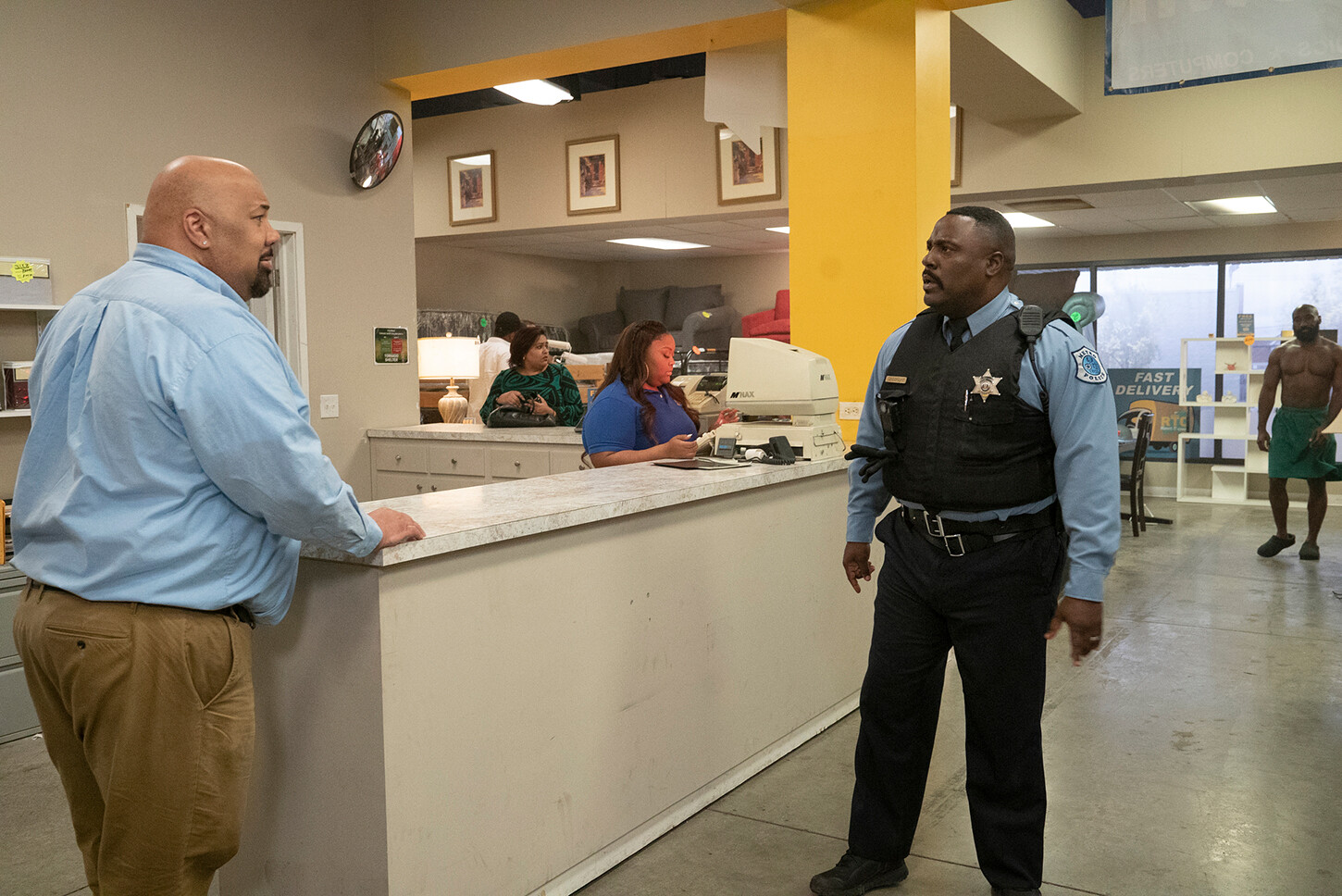Downtown Chicago is surrounded by three sides: the West Side, the North Side, and the expansive South Side, which is also the name and location of a TV series that recently completed its second season on Comedy Central.1 Set in the near future—more about this in a moment—South Side has two central characters: Simon James (played by Sultan Salahuddin) and Kareme Odom (played by Kareme Young). The former majored in the practical science of bossing, accounting, and inventory control (business administration), and the latter in “remote planetary studies”—more about this later as well. James and Odom work for a corporation called Rent-T-Own. And what makes the show futuristic is that there’s no household object that South Siders don’t rent from Rent-T-Own. The toaster is rented, the lamp is rented, the Xbox, beds, and end tables; whatever furnishes a house is not owned, but rented.
What looks like sitcom surrealism here is also the direction the world is moving in. What Marx called the consumption fund—domestic goods purchased outright and in full (in short, a capitalist temporality with a defined beginning and end)—is increasingly out of reach for wages that have been flat or falling for decades. In the near-future world of South Side, you can’t even own an end table. You rent it with the fantasy of one day owning it. In South Side’s two seasons, we never encounter a person who finally owns what they have rented for so long. Instead, the renters are always falling behind on payments, which means James and Odom spend much of their working time repossessing items from broken contracts. Once returned, the items are rented out again.
Though we are not in such a completely dystopian scenario yet, many rent-to-own schemes and operations of our time do suggest that everything is, to use an expression devised by Carlo Vercellone, “becoming-rent.”2 In the Fordist days you had wages that rose with inflation (due to escalator clauses established by union–management agreements), but in the post-Fordist world you instead have to borrow your inflation-adjusted wage increase. This translates into consumer debt, which skyrocketed following the 1990s—the decade of capital’s defeat of union power. Labor had no need for credit cards during the Trente Glorieuses following World War II. You actually owned your toaster, your fridge, your end table.
The twilight of this postwar period is the world of the 1970s TV show Good Times, which ran on CBS between 1974 and 1979 (roughly between the Nixon Shock that brought an end to the Bretton Woods system, and the Volcker Shock that initiated there is no alternative–style capitalist realism in the US).3 Good Times was set in Chicago’s North Side, which, like the South Side, represented a section of urban Black America. At the center of the show was a couple, Florida and James Evans, who lived in a housing project not unlike the North Side’s Cabrini-Green Homes, where they spent week after week trying and failing to get out of the ghetto (the sitcom’s most realistic aspect). But Florida and James actually own most of the things in their small apartment—even the art—and though James is often unemployed, he is a skilled worker and a veteran of the Korean War. In the twilight of the good times for America’s wage-earning class, James is a product of the American Century, with his worldview clearly established in a place that the early mid-century sociologists St. Clair Drake and Horace R. Cayton called the “Black Metropolis.”4 This place is very different from the economic and social world that William Julius Wilson observes in Chicago in his book When Work Disappears, and which Good Times sees a transition toward.5
The world of South Side is what emerges when work returns to the Black community in the 1990s. But this work is not the union jobs paying living wages that James Evans looked for in Good Times. Instead, it’s precarious work, with a temporality that the Australian sociologist Lisa Adkins has described precisely:
[The] critical site for the creation of surplus in present-day finance-led capitalism is not wage labor but the everyday payments that households make to ensure their existence and how this concerns both poor and more affluent households alike. Through the mundane provision of streams of contracted payments to service mortgages and pay credit cards, utilities, and other household bills, households provide income streams to financial institutions and service providers that are sold on to finance markets. In turn, these contracted payments contribute to the creation of liquid assets in the form of securities in global finance markets. In this way, households are playing a critical role in the creation of financial securities, their viability, and their profitability.6
This is not Good Times, although the 1970s sitcom did process and express the “easy credit rip-off” form of capital accumulation mentioned in its theme song. Nevertheless, what Adkins examines as the speculative regime is a completely new degree of social domination and value extraction, one that’s presently enfolding7 the entrepreneurial logic described by Michel Foucault in his 19798 analysis of human capital, an economic category first articulated by the Chicago School’s Gary Becker.9 As the period of becoming human capital (or everyday entrepreneurialism), the 1970s enfolded a form of accumulation defined by Walter Reuther and the United Auto Workers’ Treaty of Detroit in 1950.10 The full absorption of the logic of human capital by the speculative regime is what South Side expresses.
What you will not find anywhere in Good Times’ James Evans is the logic of the entrepreneur. He wants his labor to be exploited for living wages, benefits, and the security of homeownership. He is from the generation that marched on Washington over the government’s “bad check.” The very idea of borrowing money and renting endlessly is totally foreign to his notion of prosperity. NINJA (no income, no job, no assets) loans would only appear and transform American society twenty-five or so years after his character died on June 1, 1976 (he went “back to the essence”11 at age forty-four). Stuck in the projects, James and Florida Evans certainly wanted to participate in what George W. Bush would call in 2003 “the ownership society.” James and Florida dream of owning, not renting, and of getting off public assistance. It is for this reason that James finally decides to abandon Chicago—a city locked in a deindustrializing process that was actually initiated at the beginning (rather than the end) of the good times (the late 1940s12) and a city that will soon destroy a large chunk of its public housing stock (including the North Side’s Cabrini-Green)—to relocate his family to the source of the Great Migration, the rural South. Though James never completed the move—he died in a highway car crash in his home state of Mississippi while exploring prospects for relocating his family there—it was sociologically prescient. The following years of rapid gentrification in major American cities were also accompanied by a large number of Black Americans returning to the South.13
The South Side in South Side, which between 1998 and 2007 experienced the demolition of another famous public housing project, the Robert Taylor Homes, is in the late stages of gentrification.14 Those in the Black middle class, such as the show’s Sergeant Turner (played by Chandra Russell), are always on the lookout for cheap houses they can buy and then sell or rent to young white people. Everyone in South Side is hustling—or, put more respectably, is an entrepreneur. The skins of synanthropic animals are sold. James and Odom attempt to start an ambulance service akin to Uber. Umbrellas or whatever falls from “the back of a lorry” are sold on the sidewalk.15 Sergeant Turner makes a little extra scratch from middle-class women who want to “drink and paint.” There is some kind of Viagra scheme that does very well before it goes awry.
When James and Odom are not hustling (aka being entrepreneurs), they are racing (sometimes literally) around the city repossessing stuff. This is the universal outcome for anyone who rents from their employer, Rent-T-Own. The property—ottoman, toaster, laptop, bike, and so forth—is always reclaimed and reassigned to another payment contract fated to go belly up. From the beginning, ownership is nothing but a pipe dream. The genius of the show is that the goods offered in Rent-T-Own’s showroom are all well-worn. Nothing new or flashy is displayed in this business. Even the computer that manages its inventory is ancient. Enfolded Schumpeterian innovation is frozen in time.16 Commodities in this future have no future, only a use value captured by, as Lisa Adkins writes, “the calculus of securitized debt,” which is a “calculus that embeds debt and borrowing not in probables of repayment but in the possibles of servicing debt, that is, in the possibles of payment.”17
With becoming-rent capitalism, whose aim is to totalize the society of speculators, wages no longer provide Keynesian effective demand (the defining postwar form of value extraction), but instead provide revenue streams that are securitized and distributed to high-end speculators around the world. Even those working in the gig economy—an economic sector that fulfills the dream of human capital as promoted by Chicago School economists—find that any repurposed item in the consumption fund is soon captured by speculation. In this economic regime, which appears to have no outside in the South Side, James and Odom earn low wages, are entrepreneurs, and, like everyone else in their hood, own nothing and borrow everything.
“As a mode of social organization,” writes Adkins, “the logic of speculation must be recognized not simply to have replaced a previous social order in a totalizing fashion, but as emergent and as subsisting alongside other modes.”18 A better way to put this is that the emerging speculative regime is enfolding these other modes: classical value extraction, first popularized by the nineteenth-century economist and speculator David Ricardo and transferred to Marx by way of the Ricardian socialism that influenced Fredrich Engels (the labor theory of value); the Keynesian order of full employment and living wages; and the human capital mode. By the time we reach the world of South Side, they have been enfolded by another dominant form of value extraction. Are there new weapons to challenge this new capitalist temporality, the time of endless debt servicing?19 The one advanced by the season-one finale of South Side, “Litcoin,” is, of all things, cosmic time.
With Litcoin—a spinoff of Bitcoin—everyone in South Side becomes a full speculator in Adkins’s sense. Rich and poor, working or not, squatting or renting or flipping houses—all place bets on the spectacular value inflation of Litcoin. On rented smartphones and computers they watch the value of the cryptocurrency rise like a magical beanstalk.20 If it keeps rising, they will all reach the heaven of golden eggs. Of course, Litcoin crashes and everyone is left with nothing. Right after the crash, Odom, the amateur astronomer—who is, in many ways, a descendant of Michael Evans, the gifted boy in Good Times (played by Ralph Carter, whose character was destined to enter the middle class by way of an advanced education)—is depressed by the lost opportunity to transform his peak Litcoin value into the purchase of a powerful telescope. A rare comet is making its way around the solar system and he wants to see it. But he is broke again. At this point, the show makes a leap into the cosmic. All along, and all around the South Side, they have been surrounded by the cosmic, which can only be accessed by a form of wonder (thaumazein) that Hannah Arendt described in the chapter on Socrates in her book The Promise of Politics:
Were man ever to lose the faculty of asking ultimate questions, he would by the same token lose his faculty of asking answerable questions. He would cease to be a question-asking being, which would be the end, not only of philosophy, but of science as well. As far as philosophy is concerned, if it is true that it begins with thaumazein and ends with speechlessness, then it ends exactly where it began. Beginning and end are here the same, which is the most fundamental of the so-called vicious circles that one may find in so many strictly philosophical arguments.21
The weapon against the capitalist totality determined by the universalization of speculation is none other than the universe itself. But how? It is by way of a wonder that detonates upon the collision between speculative temporality and the temporality of the cosmic. This is a wonder that breaks the spell of speculative time. It is also a wonder that exposes a form of time that precedes the clock time described by E. P. Thompson in “Time, Work-Discipline, and Industrial Capitalism,” a 1967 paper that influenced Moishe Postone and Lisa Adkins. This is sacred time, the time of the gods and their voices in the clouds. But in South Side, sacred time is secularized. It’s now the time of really existing stars that, in James Joyce’s words, wander “from immeasurably remote eons to infinitely remote futures.”
In the final moments of the first season, Odom and others in a basement apartment filled with rented stuff drift through the vast interstellar spaces outside of capitalist totality. And as they drift, we hear the second track from the South Side pastor T. L. Barrett’s 1971 gospel soul LP Like a Ship (Without a Sail), entitled “Wonderful.”
It has been granted a third season by the gods of HBO.
Christian Marazzi writes: “If one really wants to speak of ‘irresponsible companies’ to describe the paradigm of shareholder value—adopted by companies over the last thirty years—one would do well to speak of the transformation of the production process based on the ‘profits becoming rent,’ to use Carlo Vercellone’s apt expression.” Marazzi, The Violence of Financial Capitalism (Semiotext(e), 2011), 32.
Paul Volcker, a Democrat, actually played a role in both shocks: one as an economic advisor to Richard Nixon and the second as Jimmy Carter’s head of the Fed. “There is no alternative” is a slogan used by Margaret Thatcher to suggest the inevitability of capitalism and austerity policies.
St. Clair Drake and Horace R. Cayton, Black Metropolis: A Study of Negro Life in a Northern City (University of Chicago Press, 1945).
Wilson writes: “Few observers of the urban scene in the late 1960s anticipated the extensive breakdown of social institutions and the sharp rise in rates of social dislocation that have since swept the ghettos and spread to other neighborhoods that were once stable. For example, in the neighborhood of Woodlawn, located on the South Side of Chicago, there were over eight hundred commercial and industrial establishments in 1950. Today, it is estimated that only about a hundred are left, many of them represented by tiny catering places, barber shops, and thrift stores with no more than one or two employees.” William Julius Wilson, When Work Disappears: The World of the New Urban Poor (Knopf, 1996), 37.
Lisa Adkins, The Time of Money (Stanford University Press, 2018), 4.
I use this key word from the work of twenty-first century American physicist David Bohm to break with a term in the philosophy of Hegel, “sublation.”
The final episode of Good Times aired on August 1, 1979.
“Human capital” entered the mainstream in 2005 by way of Stephen J. Dubner and Steven Levitt’s book Freakonomics, the objective of which was to make Chicago School neoclassical theories look cool, like giving Milton Friedman a mohawk.
“We call the post–World War II institutional arrangements the Treaty of Detroit, after the most famous labor–management agreement of that period.” Frank Levy and Peter Temin, “Inequality and Institutions in Twentieth-Century America,” in Economic Evolution and Revolution in Historical Time, ed. David Weiman, Paul Webb Rhode, and Joshua L. Rosenbloom (Stanford University Press, 2011), 358.
Intelligent Hoodlum, “Grand Groove,” 1993 →.
In his book The Origins of the Urban Crisis: Race and Inequality in Postwar Detroit (Princeton University Press, 1996), historian Thomas J. Sugrue argues that the deindustrialization of Detroit did not begin in the 1970s, as many believe, but actually at the peak of the city’s economic greatness, the second half of the 1940s. Around this time, the Big Three automakers (General Motors, Ford, and Chrysler) began to relocate factories from the city to the suburbs and other states where labor was cheaper and unions weaker.
This was the subject of Maya Angelou’s 1998 film Down in the Delta.
The YouTube user who posted the demolition of the last Robert Taylor Homes tower warns that the footage might distress those who “used to live (in the) building” →.
Smiley Culture, “Cockney Translation,” 1984 →.
For the Austrian-American economist Joseph Schumpeter, a contemporary of John Maynard Keynes, the creative destruction of old products and production technologies and processes was “the essential fact about capitalism.” Progress, a temporal concept first worshiped by the Victorians, could not happen without the destruction of the old and the introduction of the new.
Adkins, The Time of Money, 8.
Adkins, The Time of Money, 2.
Lisa Adkins is of the mind that even increasing wages, which have been stagnant since the end of the good times, would be inadequate. She writes: “I … necessarily engage with and disrupt (the assumption) that redistributions of resources, especially redistributions of money, can redress exacerbating forms of post-financial-crisis inequality.” Adkins, The Time of Money, 12.
In the cryptocurrency world, there is an Ethereum-based protocol called Beanstalk Farms. It recently lost $182 million to an “attacker” →.
Arendt, The Promise of Politics (Schocken Books, 2005), 34. A few pages earlier she writes: “Plato defines the origin of philosophy … ‘Wonder is what the philosopher endures most; for there is no other beginning of philosophy than wonder” (32).






